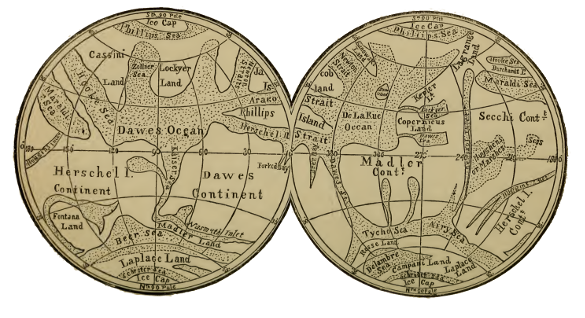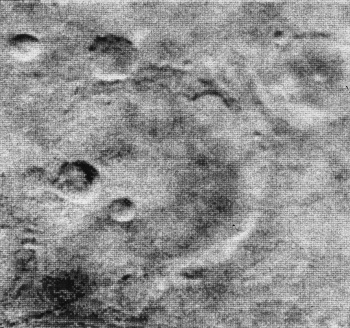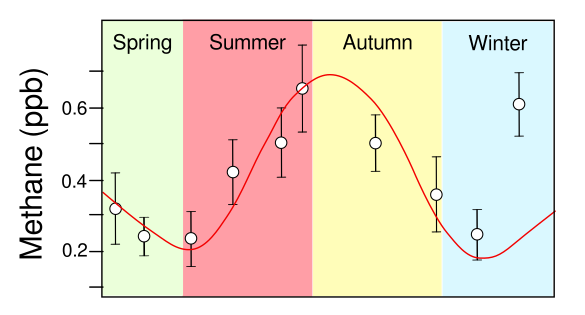Martian Atmosphere
January 27, 2020
Early
observations of
Mars revealed a
seasonal variation in its
color and
luminance. It was easy for
planetary astronomers to
imagine surface vegetation blooming in the Martian
spring, thriving in the Martian
summer, retreating in the Martian
autumn, and becoming
dormant in the Martian
winter. However, some observations were contrary to this idea of a vegetated Mars. In 1784,
William Herschel (1738-1822), who is famous for his discovery of the
planet,
Uranus, deduced that Mars had very little
atmosphere when he observed its
transit across
stars.
Despite Herschel's observation, people still had hope for
life on Mars, since Mars and
Earth are so similar. A Martian
day is just 37 minutes, 22 seconds longer than an Earth day, and its
axial tilt to its
orbital plane, which is responsible for the Martian seasons, is 25.19°, quite close to Earth's 23.44°. A Martian
year, however, is 2.1354 Earth years.
Many in the
19th century believed that most planets harbored life. In 1862,
French astronomer and
author,
Camille Flammarion (1842-1925),
published his
La pluralité des mondes habités (The Plurality of Inhabited Worlds), a
book that promoted this idea.[3] Unfortunately, Flammarion was
dismissed from his position at the
Paris Observatory within a year of its publication, an event perhaps caused by the book's content.
Many in the early 19th century believed that the darker features on Mars were
oceans, and the lighter features were
land, and the idea of life on Mars was reinforced by the
mapping of Martian "
canals" and publications about Mars by
Percival Lowell (1855-1916) in the period 1895-1906.[1-2] The possibility of
intelligent life on Mars was the
plot of
H.G.Wells' (1866-1946) The War of the Worlds, published in 1897.[4]

An 1874 map of Mars by Dawes. This is fig. 22, Chart of Mars, on page 167 of Flowers in the Sky External by Richard Proctor.[6] Martian canals were mapped by Italian astronomer, Giovanni Schiaparelli (1835-1910) in 1877. His use of the Italian word, canali, for channel was mistranslated to mean a water canal, and this sparked speculation that intelligent Martians were using such canals to transport water from the polar regions. Subsequent observations by better telescopes in the early 20th century indicated that these features were optical illusions. (From the Library of Congress Digital Collections. Click for larger image.)[5-6]
Even
technically-minded people found Lowell's arguments convincing.
Inventor of the first practical
telephone,
Alexander Graham Bell (1847-1922), wrote an eight page
letter to his
wife in 1909 about life on Mars in which he states that "there is no escape from the conviction that Mars is inhabited by a highly civilized and intelligent race of beings carrying on a process of
agriculture, and wringing
subsistence."[1] However, there was strong
scientific evidence that the Martian atmosphere was quite unlike our own. In 1874, astronomer and subsequent
director of the
Lick Observatory,
William Wallace Campbell (1862-1938), used
spectroscopy to confirm the absence of
oxygen and
water on Mars.
As they say,
a picture is worth a thousand words. On July 15, 1965,
NASA's Mariner 4 spacecraft acquired the first closeup images of the Martian surface. The crude technology of that time allowed for acquisition of just 21 images, each of which required six hours to be
transmitted back to Earth, and the entire
data stream of the mission was less than a
megabyte. The images revealed a
Moon-like,
cratered surface. Other
data indicated a surface atmospheric
pressure of 4.1 to 7.0
millibars (410 to 700
pascals).

An image of the Martian surface, taken from a distance of 7,830 miles on July 14, 1965, by the Mariner 4 spacecraft.
(NASA/JPL image, via Wikimedia Commons. Click for larger image.)
Subsequent Mars missions, starting with the
Viking orbiters, confirmed that Mars is a
dry,
desert planet. While the present atmospheric conditions will not allow
liquid surface water, the vast Martian
canyons indicate that water was abundant on Mars
billions of years ago. The Martian polar regions do contain a mixture of
water ice and
carbon dioxide ice, and these caps vary in size with the Martian
seasons. Water and carbon dioxide,
sublimated from the polar regions in warmer
weather, enter the atmosphere, and they can deposit as a
frost at high
latitudes, and elsewhere at high
elevations. This frost causes color and luminance changes.
Observations at increased
resolution have led to many scientific discoveries. As
physicist,
Floyd K. Richtmyer (1881-1939) wrote in his article,
The Romance of the Next Decimal Place, "The whole history of physics proves that a new discovery is quite likely lurking at the next decimal place."[8] Subsequent observations of the Martian atmosphere have shown unexplained seasonal variation in oxygen and
methane concentration (see figure). These
phenomena have been reviewed in recent
publications.[9-13]

Seasonal variation of atmospheric methane on Mars. These reading of atmospheric methane in Gale crater were taken by NASA's Curiosity rover for nearly three Martian years; that is, about six Earth years). There's a definite, and unexplained, peaking each Martian summer. Earth's atmospheric methane is nearly at the 2000 parts per billion level, so Martian methane concentration is very small. (Created using Inkscape from NASA/JPL-Caltech data. Click for larger image.)
Two international
research teams have
published observations of Martian methane in a 2018 paper in
Science and a recent paper in the
Journal of Geophysical Research.[9-11] The
Tunable Laser Spectrometer on the Curiosity rover found that the background levels of methane have a
mean value of 0.41 ± 0.16
parts per billion by volume (ppbv) at a 95%
confidence interval, but the methane concentration also exhibits a strong, repeatable seasonal variation of 0.24 to 0.65 ppbv.[9] While a variation might be expected by
ultraviolet light decomposition of
meteor-delivered organic compounds and an annual surface pressure cycle, the variation is larger than can be accounted by these processes.[9, 12-13] Also appearing are higher temporary spikes of the order of 7 ppbv that might be associated with methane release from small, localized surface or subsurface
reservoirs.[9] Since methane in Earth's atmosphere arises predominantly from
biological processes, this might be evidence for Martian
methanogenic bacteria.[9]
The recent study, published in the Journal of Geophysical Research, used the
Sample Analysis at Mars instrument on the Curiosity rover to measure the concentrations of Martian carbon dioxide,
nitrogen,
argon-40, oxygen, and
carbon monoxide.[11] Measurements have now been completed for multiple years, and they show that the annual average composition is 95.1% carbon dioxide, 2.59% nitrogen, 1.94% argon-40, 0.161% oxygen, and 0.058% carbon monoxide.[11] While nitrogen and argon show seasonal changes caused by pressure changes, oxygen has been observed to show a significant and unexpected year‐to‐year and seasonal variability caused by some unknown atmospheric or surface process.[11] The oxygen peaked by 30% in the spring and summer, then dropped in the fall.[11] Such changes suggests that oxygen is being created by by some process, and then removed.[11]
References:
- Percival Lowell, "Mars," Lowell Observatory (1894).
- Percival Lowell, "Mars as the abode of life," Macmillan (New York: 1910), 288 pp., via the HathiTrust Digital Library.
- Camille Flammarion, La Pluralité Des Mondes Habités, Didier (Paris: 1877).
- H. G. Wells, "The War of the Worlds," via Project Gutenberg.
- Seeing and Interpreting Martian Oceans and Canals, Digital Collections, Library of Congress.
- Richard Proctor, "Flowers in the Sky External," A.C. Armstrong and Son (New York: 1874) (PDF file).
- Kelli Mars, "55 Years Ago: Mariner 4 First to Mars," NASA Website, November 27, 2019.
- F. K. Richtmyer, "The Romance of the Next Decimal Place," Science, vol. 75, no. 1931 (January 1, 1932), pp. 1-5, DOI: 10.1126/science.75.1931.1 .
- Christopher R. Webster, et al., "Background levels of methane in Mars’ atmosphere show strong seasonal variations," Science, vol. 360, no. 6393 (June 8, 2018), pp. 1093-1096, DOI: 10.1126/science.aaq0131. A PDF copy of the paper is available here.
- What causes the seasonal variation of methane on Mars?, Lunar and Planetary Institute of the Universities Space Research Association.
- Melissa G. Trainer, et al., "Seasonal variations in atmospheric composition as measured in Gale Crater, Mars," Journal of Geophysical Research (Draft Article, November 12, 2019), doi: 10.1029/2019JE006175.
- Hot Oxygen And Carbon Escape From The Martian Atmosphere, Astrobiology Press Release, November 4, 2019.
- Hannes Gröller, Herbert Lichtenegger, Helmut Lammer, and Valery I. Shematovich, "Hot oxygen and carbon escape from the martian atmosphere, arXiv, November 4, 2019. Published as Hannes Gröller, Herbert Lichtenegger, Helmut Lammer, and Valery I. Shematovich, "Hot oxygen and carbon escape from the martian atmosphere, Planet. Space Sci., vol. 98 (August 2014), pp. 93-105, https://doi.org/10.1016/j.pss.2014.01.007.
Linked Keywords: Observation in science; Mars; season; seasonal; color; luminance; planetary science; planetary astronomer; imagination; imagine; lithosphere; surface; vegetation; bloom; blooming; spring (season); summer; autumn; dormancy; dormant; winter; William Herschel (1738-1822); planet; Uranus; atmosphere of Mars; transit (astronomy); star; life on Mars; Earth; diurnal cycle; day; axial tilt; orbital plane; year; 19th century; France; French; astronomer; author; Camille Flammarion (1842-1925); publishing; publish; book; termination of employment; dismissed from his position; Paris Observatory; ocean; land; map; mapping; Martian canal; Percival Lowell (1855-1916); intelligence; intelligent; dramatic structure; plot; H.G.Wells' (1866-1946); The War of the Worlds; 1874 map of Mars by Dawes; Mars; Italian; Giovanni Schiaparelli (1835-1910); word; channel (geography); translation; mistranslated; water canal; speculative reason; speculation; Martian; transport; geographical pole; polar region; telescope; 20th century; optical illusion; Library of Congress Digital Collections; technology; technically-minded; invention; inventor; telephone; Alexander Graham Bell (1847-1922); letter (message); wife; agriculture; subsistence agriculture; scientific evidence; director; Lick Observatory; William Wallace Campbell (1862-1938); spectroscopy; oxygen; water; a picture is worth a thousand words; NASA; Mariner 4; spacecraft; transmitter; transmitted; data stream; megabyte; Moon; Moon-like; impact crater; cratered; data; pressure; bar (unit); millibar; pascal (unit); image; mile; Wikimedia Commons; Viking program; Viking orbiter; arid; dry; desert; planet; liquid; canyon; geologic time scale; billions of years ago; water ice; dry ice; carbon dioxide ice; season; sublimation (phase transition); sublimate; weather; frost; latitude; elevation; resolution; physicist; Floyd K. Richtmyer (1881-1939); methane; concentration; phenomenon; phenomena; scientific literature; publication; seasonal variation of atmospheric methane on Mars; Gale crater; Curiosity rover; year; Earth; Earth's atmospheric methane; parts-per notation; parts per billion; Inkscape; research; Science (journal); Journal of Geophysical Research; Tunable diode laser absorption spectroscopy; Tunable Laser Spectrometer; arithmetic mean; parts per billion by volume; confidence interval; ultraviolet light; chemical decomposition; meteorite; meteor-delivered; organic compound; reservoir; biology; biological; methanogenic bacteria; Sample Analysis at Mars; scientific instrument; nitrogen; argon-40; carbon monoxide.